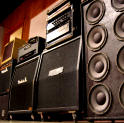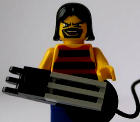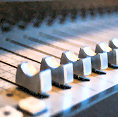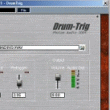 Here’s a classic thread from Prosoundweb with some of the pros sharing their thoughts on getting a thick guitar sound:
Here’s a classic thread from Prosoundweb with some of the pros sharing their thoughts on getting a thick guitar sound:
It’s a lot of things, but most importainly[sic] it’s the blend of guitars and bass in the arrangement. If you listen closely to your fav guitar sounds, the guitars aren’t really that big on their own, but when played with the bass…..
Also, it helps to have a good player, with an in tune guitar, with a well maintained head and cab, and then you can throw up a couple of mic’s, blend them properly without phase problems (which cause comb filtering/cancellation of freq’s that make your guitars not huge), then mix them well and your done.
From Homerecording.com, How do I improve miking my guitar amp?
Get the amp cabinet off the floor. Use 1 ear and act like a mic. Move around and listen to the sound. If you like the sound, put the mic there. Many times, there is no place that has the sound you want. If that is true, then use a different amp, pedel, guitar etc. Don’t put the mic to the cloth. Put about 2″ from it. You will get a better sound if you back off on the distortion (if you are after distorted guitars). Don’t try to get a super heavy sound like some records as they double, triple etc. guitars. You are after a good sound with detail. More distortion kills the detail and hogs the available space for the total guitar sound. Doubling shitty guitar sounds only makes things worse.
… and some thoughts on thickening guitars:
Boost a wide band from80hz to about 150 hz.
Boost till it sounds fat.
Then put a multiband compressor next in line (Like a waves C4 or something of the like) to push the lows down under control. Doing this keeps the lows fat but not out of wack. This typically works well for me. Youll need to experiment, but its a good possiblilty you can make it work for you with some patience.
And finally, more on the same from TapeOp – Big ass guitar tone:
Whatever distortion/overdrive you think you need live, scale back by a 1/4 or 1/3 when you record.
Also: use heavier gauged strings on your guitar.
Tags: guitars

 A custom reverb can add a unique signature to your recordings. And since practically every space reverberates, a home made reverb often requires no more than a speaker, and microphone to capture reflected sound. Understandably, then, reverb units are popular do-it-yourself projects for musicians and recording engineers.
A custom reverb can add a unique signature to your recordings. And since practically every space reverberates, a home made reverb often requires no more than a speaker, and microphone to capture reflected sound. Understandably, then, reverb units are popular do-it-yourself projects for musicians and recording engineers.  I previously discussed the
I previously discussed the  In audio, a transient is commonly defined as “an abrupt or sudden change in level.” We associate transients with sharp, harsh sounds: Think of cymbal crashes, hard-strummed acoustic guitar, and a singer’s T’s and CH’s.
In audio, a transient is commonly defined as “an abrupt or sudden change in level.” We associate transients with sharp, harsh sounds: Think of cymbal crashes, hard-strummed acoustic guitar, and a singer’s T’s and CH’s. While it has nothing to do with music, this story of
While it has nothing to do with music, this story of  From homerecording.com, a collection of
From homerecording.com, a collection of  A couple of weeks ago, Avril Lavigne found herself facing allegations that she’d plagiarized a 30 year old song. (Here’s some
A couple of weeks ago, Avril Lavigne found herself facing allegations that she’d plagiarized a 30 year old song. (Here’s some 
